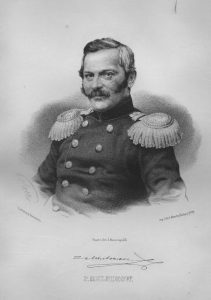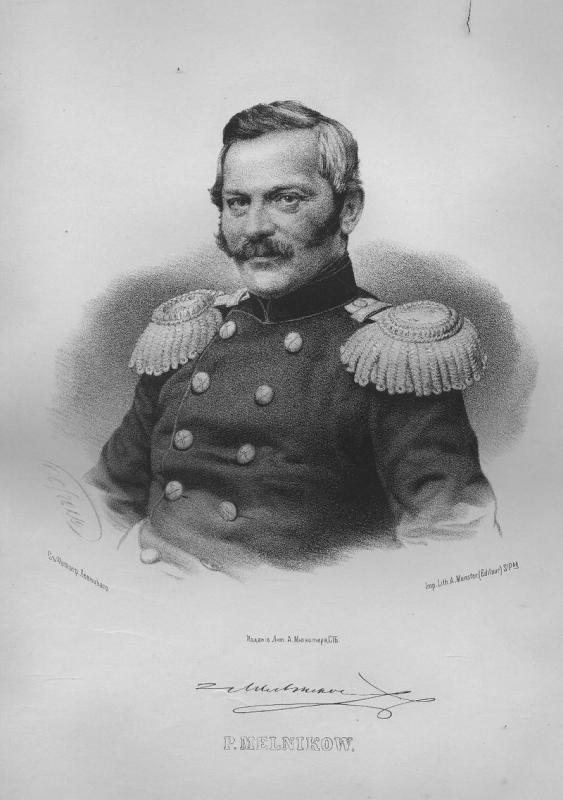A Railway transport engineer, the first Russian Minister of Transportation, member of the Russian State Duma. Pavel Melnikov was born in Moscow (according to other data, in the Tula province) on July 22, 1804 (August 3). Very little is known about his ancestry, only the fact that he comes from a landlord family. He was educated in a private boarding school, and after finishing it he entered the St. Petersburg Institute of Civil Engineers in 1820, and because of his luminous knowledge, he was immediately enrolled in the 3rd year. In 1825 at the age of twenty-one Pavel Melnikov graduated the high school with distinction. His name was immortalized in marble plate among the most talented high school students’ names.
After the graduation P. Melnikov worked in his alma mater as a teacher of applied mechanics, since the year of 1833 as a professor of applied mathematics. At the same time he read lectures at the Artillery School of St. Petersburg Mining Institute.
Together with the teaching work Pavel Melnikov was dealing with the problems of Russian waterways: in 1826 he worked on the “restraint” of the Volhov River rapids, in 1830 he oversaw the works to improve shipping on the Koknese rapids of Daugava River and carried out research on connecting Daugava with Lovat. In 1836 his book “Основания практической гидравлики, или О движении воды в различных случаях и действии ее ударом и сопротивлением” [The basics of practical hydraulics, or On the movement of water in different cases and its effect with impact and resistance] was published.
During the time period from 1828 to 1841 Pavel Melnikov often visited Dinaburg and was well aware of the urgent problem of the town and fortress – the devastating spring floods. Military engineers who were involved in the solving of this problem, offered either difficult to implement or very expensive solutions. Captain P. Melnikov, after analyzing the many year statistics on the Daugava River water level fluctuations, came to the conclusion that flooding of Dinaburg can be avoided by building a levee on the right bank of the Daugava River. Water level control was conducted by the two floodgates: at the mouth of the small river Shunica where it meets Daugava, and behind the fortress camp barracks. In year of 1833 the Tsar approved the project, and the long-awaited construction of the dam finally started. The dam, which was 7 km long, was completed in 1841, the height of embankments ranged from 4.2 to 6.4 meters. A highway was built on the upper part of the dam (now Daugavas Street and part of 18.Novembra street). Later trees were planted and a wooden railing was built on the roadside. The dam became a remarkable object in the city. Captain Melnikov’s calculations were so precise that even after century and a half his dam did not disappoint even for once, always safely protecting the central part of the city from flooding.
In 1830s he visited England, Austria, Belgium, France, and USA, where he studied the techniques of constructing railway, bridges and different hydrotechnical structures. For the excellently performed tasks he was awarded with the rank of colonel. In 1835 Pavel Melnikov published a new book “О железных дорогах” [On the railroads], which proved economic feasibility and technical possibilities of building the railroad network in Russia. He was one of the technical drafters of the first Russian railroad “St. Petersburg-Moscow” and personally persuaded the Emperor Nikolai I of its construction usefulness. From 1842 to 1851 Pavel Melnikov actually led the construction of this railroad and was awarded the Order of St. Anna for his achievements.
According to the P. Melnikov’s blueprints a railway line Riga-Dinaburg (1861) and St. Petersburg-Warsaw (1859-1862) were built. The location of Dinaburg at the intersection of these two railways largely determined the future growth of the city.
The scientific activities of Pavel Melnikov laid the foundation for the railway science in Russia. He developed railroad wagon building principles and was able to put many of his theoretical elaborations into practice. For his researches, practical and organizational performance P. Melnikov was greatly appreciated and elected an honorary member of the Russian Academy of Sciences.
Contemporaries described him as a smart, very public, eloquent, joyful person, who was very ascetic in everyday life, and was devoted only to work.
In 1865 in Russia a Ministry of Transportation was established and Lieutenant General P. Melnikov became its first minister, and worked in Ministry until 1869.
After leaving the tsar’s service, Pavel Melnikov moved to the village of Luban and focused on charity: on his private funds the village church was built, together with retirement home, the school and a shelter for the orphans whose parents died in transport accidents. He bequeathed all of his savings for the maintenance of these facilities. Here he began to write his monograph in 4 parts “Сведения о русских железных дорогах” [Information on Russian railways], only the first part of his work survived till nowadays.
In 1872 Pavel Melnikov was appointed a member of the State Duma, but was released from the the active work.
Died on July 22, 1880 (August 3) in Luban village and buried under the altar of the local church.
The contribution of P. Melnikov to the Russian railway transport development is highly valued: on August 1, 2003 on Komsomolskaya Square in Moscow a monument of P. Melnikov was unveiled, and in October 2005 an award was approved by the Russian Federation Ministry of Transport – the Pavel Melnikov medal.
Connections with Daugavpils: designed a protection embankment in Daugavpils and Riga-Dinaburg railway line.



